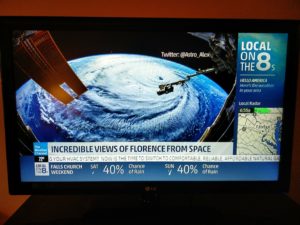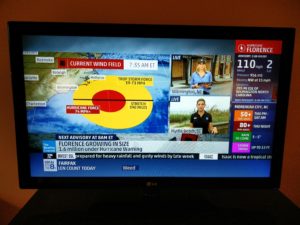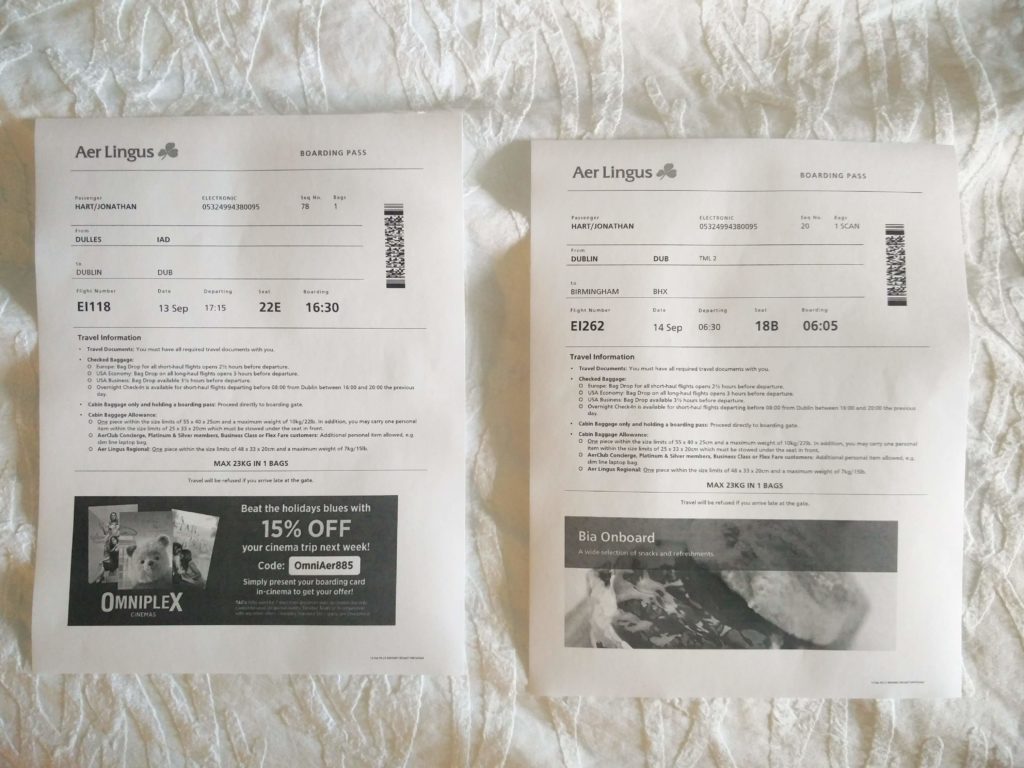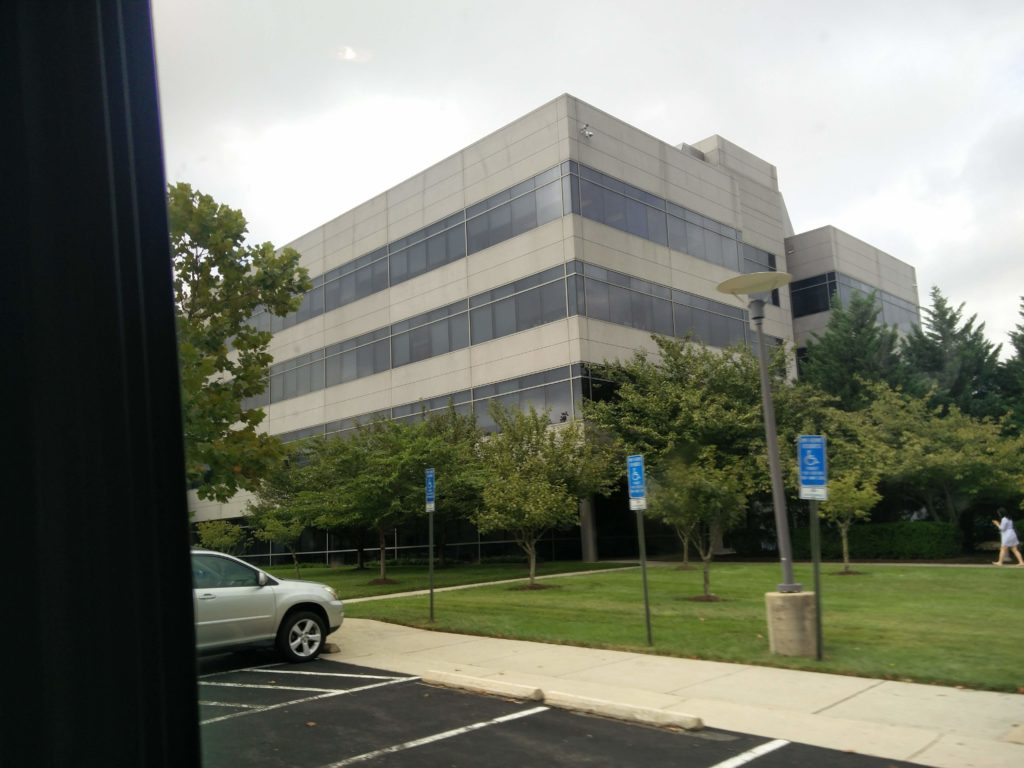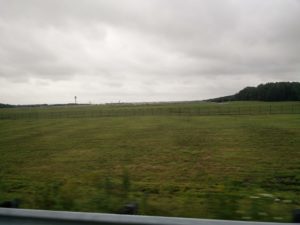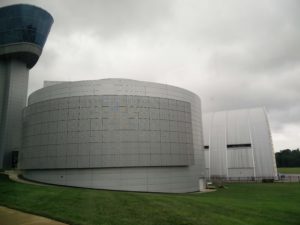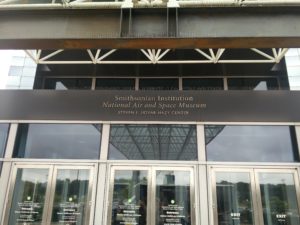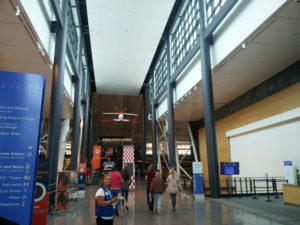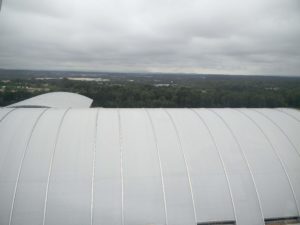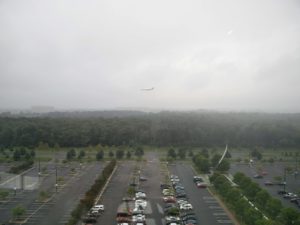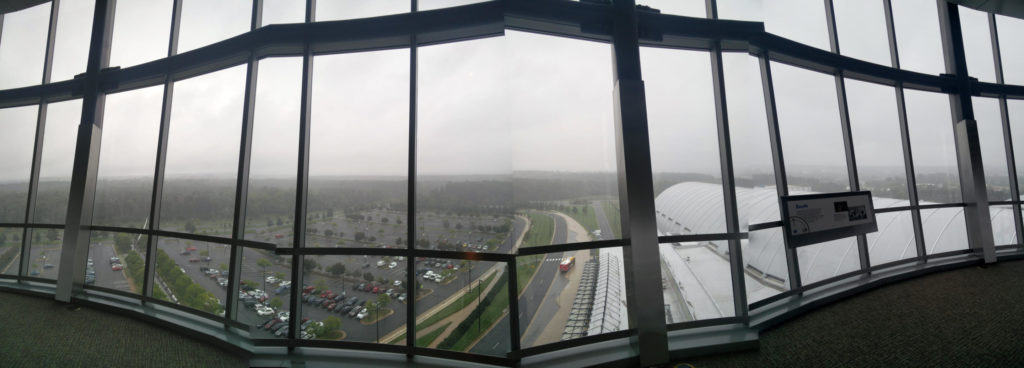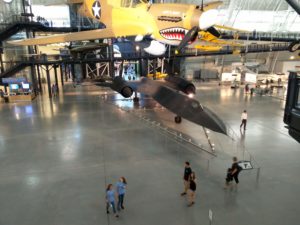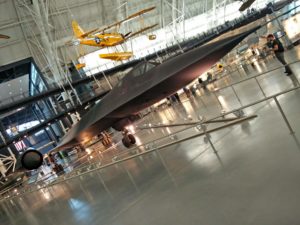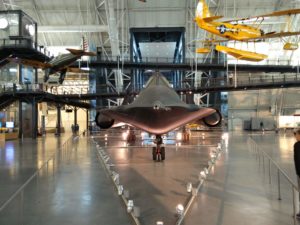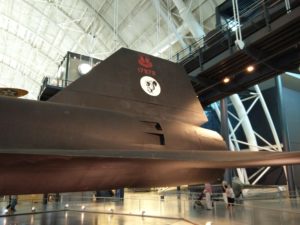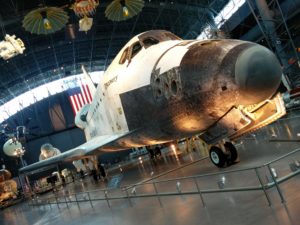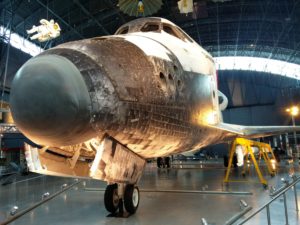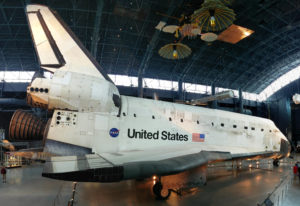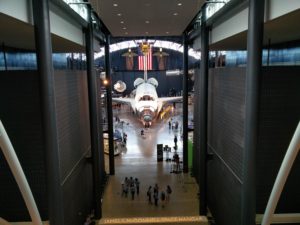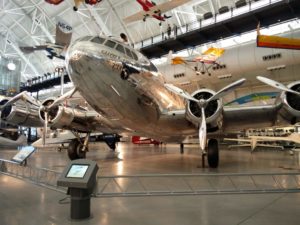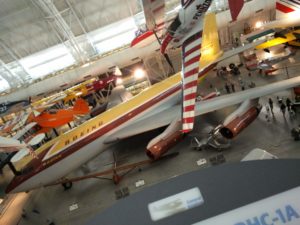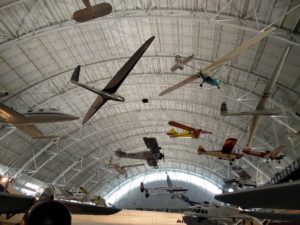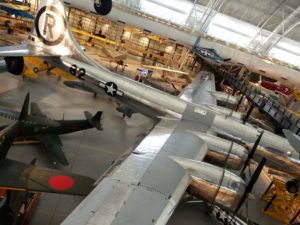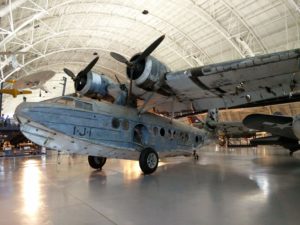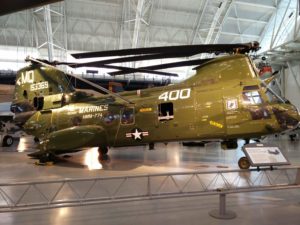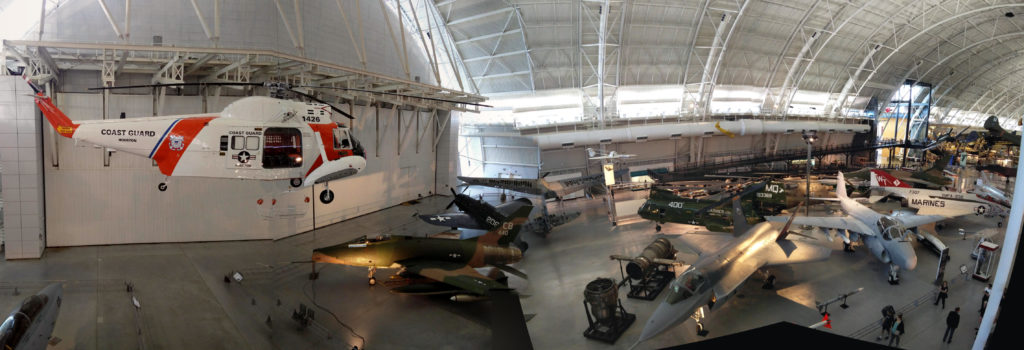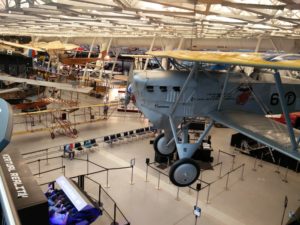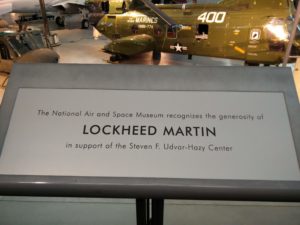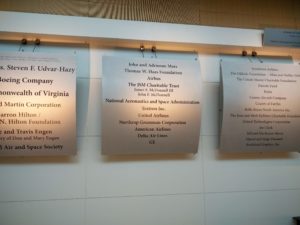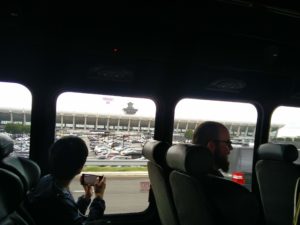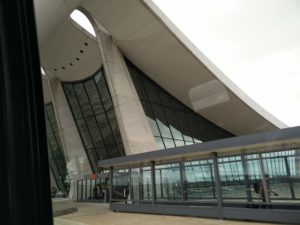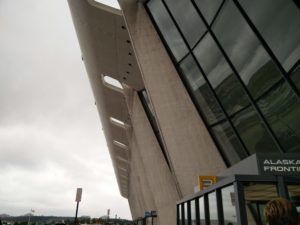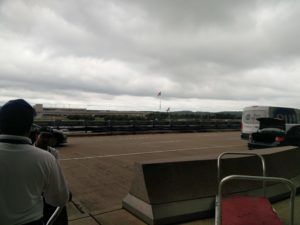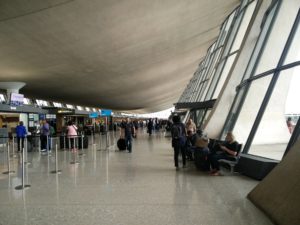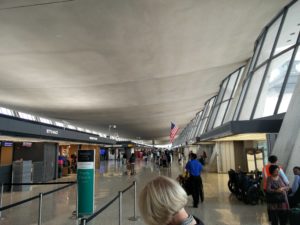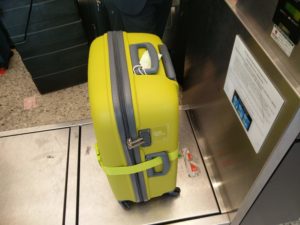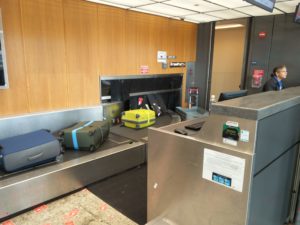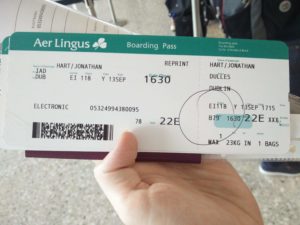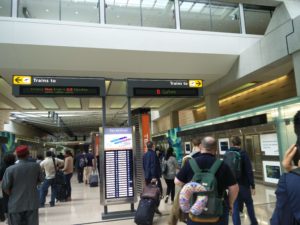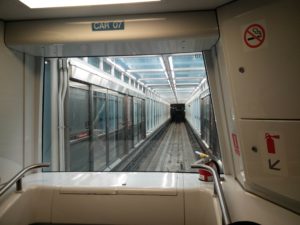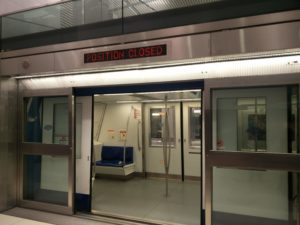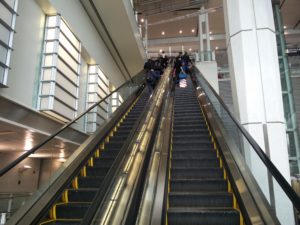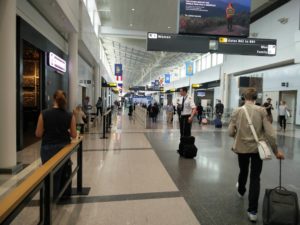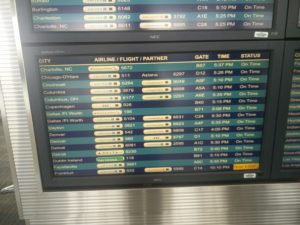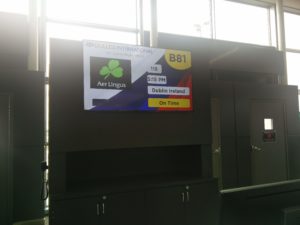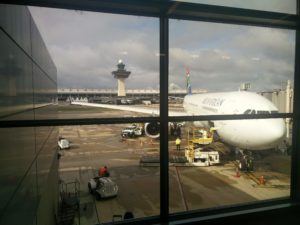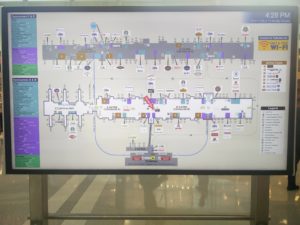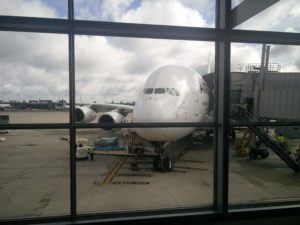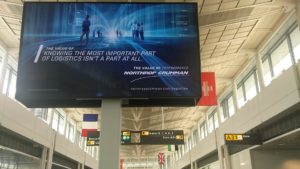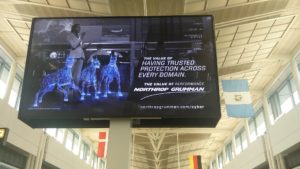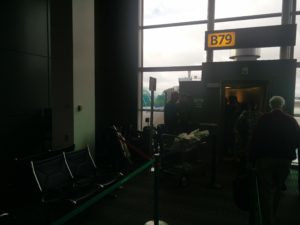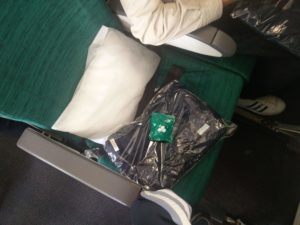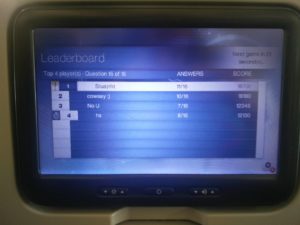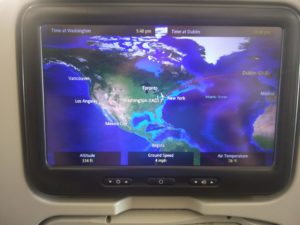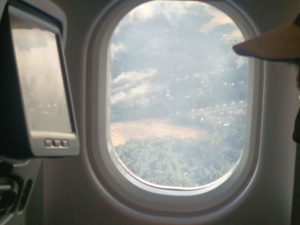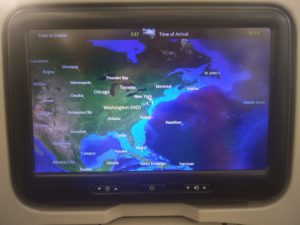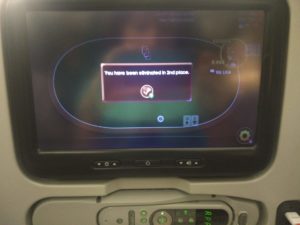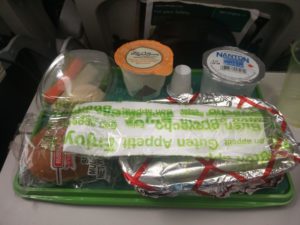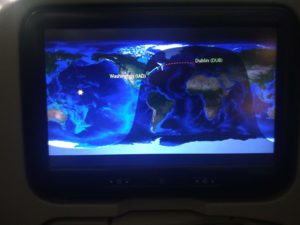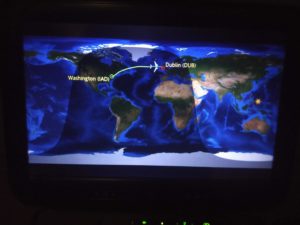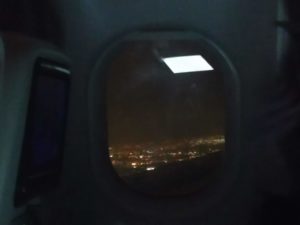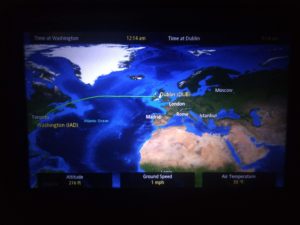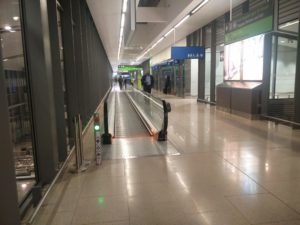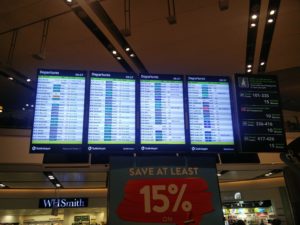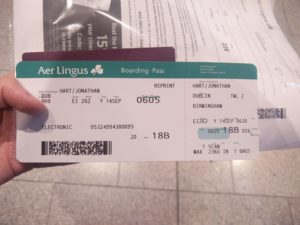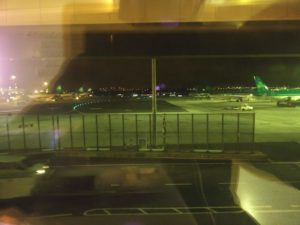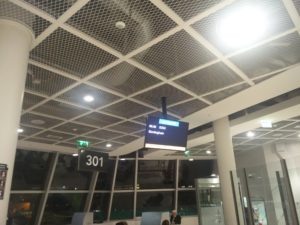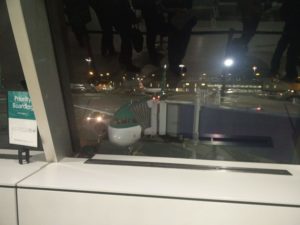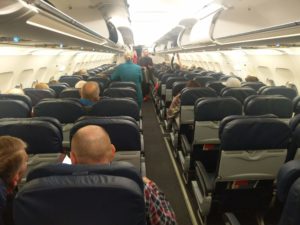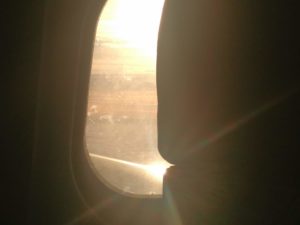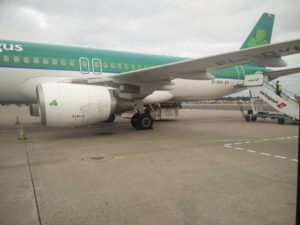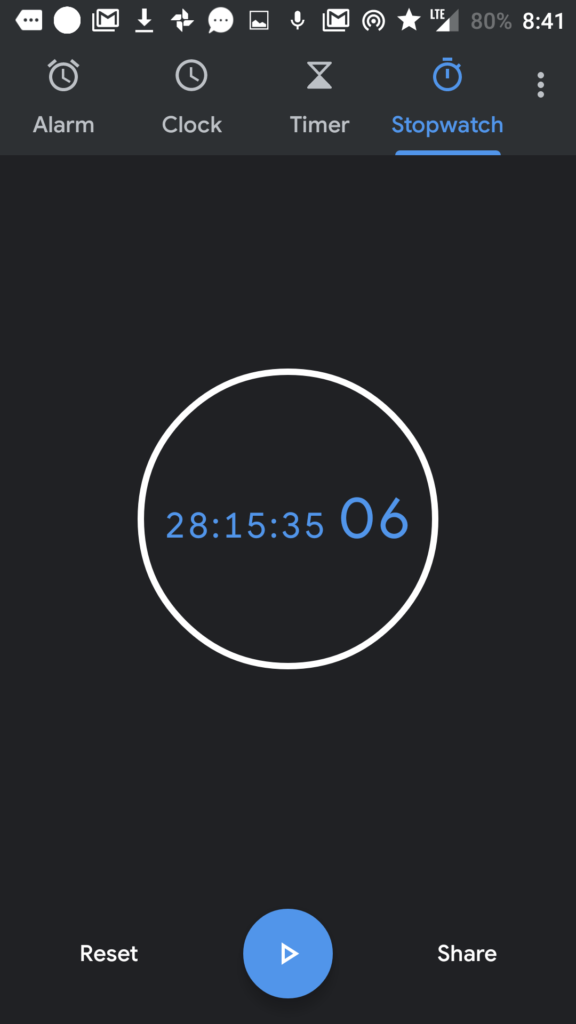Do you remember that I’ve been going on about Hurricane Florence since we’ve been in the United States? Good. Do you remember that I’ve been watching The Weather Channel as it’s the only channel that I’ve really been able to get? Good. Do you remember that there’s been mass evacuations going on? Good. Do you remember that the hurricane has had it’s category degraded and is going to be making land further south than where we are located? Good. Now, imagine that you’ve got said channel on in the background while you’re finalising packing your case, and the presenters are talking about said hurricane, when you hear a loud buzzing noise and the TV displays the following:
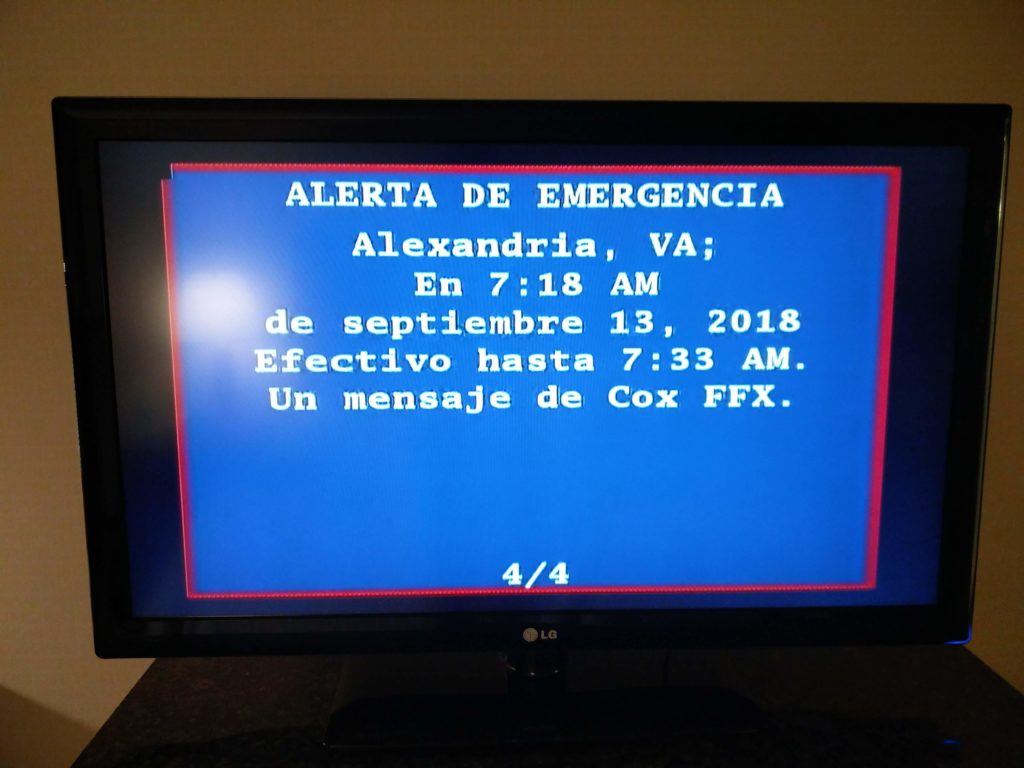
This noise went on for quite a while. As did the messages. And they were all in Spanish. (I’ve got nothing against the Spanish language, but when most people speak English, please put those messages first). I don’t what you would have done in this situation, but this certainly made me slightly panic. It was coming up to 7:20, and from what I could make out, something was going to happen at half 7. I was just about to go out into the corridor to see if anyone else saw the alert (after pausing to take the photo you’ve just seen, of course – could I be more dedicated to reporting everything about this trip for you while possibly risking my life? I think not) when I noticed that the message on the TV had updated:
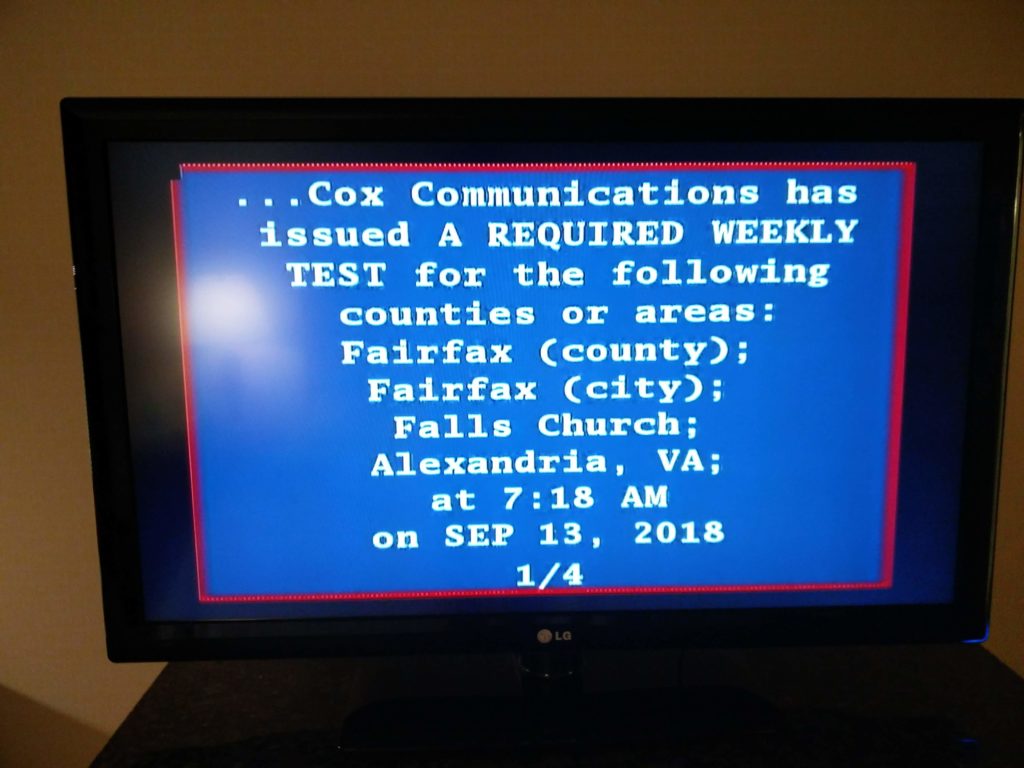
Oh, so it was a test. For the United States Emergency Alert System. And they do this test weekly. What a great idea – testing alerting system work is important. Except that as a tourist you’re not informed that such tests happen. As far as I’m aware, we don’t have such tests in the UK, so seeing something like this appear on the TV when you’re a visitor makes you think that something very bad has happened. Can I just make one more tip before I get on with the rest of what we got up to today? Yes? Whenever someone is going to be travelling to the USA, they’re told to visit the FEMA Integrated Public Alert & Warning System article. Thank you.
I’m going to miss the hurricane. Not just that we’re going home and will be nowhere near it, but also all that I’ve really watched on TV is information about it, and going back to the UK, it most likely won’t be mentioned. I think I’ve become sentimental to it. However, I think that the hurricane has become sad that we’re leaving too, as it’s been downgraded to a category 2, but while the winds may now only be a gentle 110MPH instead of 134MPH, there does seem to be a very large amount of rainfall that is going to fall, and now there’s chances of tornadoes being formed too.
While we were waiting in the hotel lobby for everyone to meet up for us to have breakfast, I was asking if anyone else had seen the test warning messages. Another student said that they’d also noticed it (if your TV was on, how could you not?) and had also reacted in pretty much the same way as me. We had our last breakfast at the hotel, went back to our rooms to made sure that everything was packed in our cases and we had the correct boarding passes, then met up again in the hotel lobby. After checking ourselves out, around quarter past 9, we got onto the minibus to be taken to our first stop.
We were heading to a satellite manufacturing centre, which had recently taken over by Northrop Grumman in July of this year (they company used to be Orbital ATK, but had since been rebranded as Northrop Grumman Innovation Systems). We met Diane outside Building 1 and went inside. As satellites seem to be expensive and complex things, we had to sign in (it’s quite difficult for nationals to get in, yet alone foreign nationals, so we were lucky to be cleared for this visit). This signing-in process involved having our passports checked, visitor identity badges being handed to us and for each of us in turn to sign a screen saying that we agreed to not take any photos or videos, and to not take in drugs or any other illegal items. Luckily this wasn’t anything too important, as most of the students signed the screen first, then realised there was a sign near it saying what they’d just signed for. What this does mean is that unfortunately there’s no photos to look at, which you’ll be pleased about, and that the best you’ve got for descriptions of how things looked is my memory, descriptive writing style and any articles I can find online.
Once everyone had been signed in and handed security badges, we were escorted to another building, Building 5, which was numbered 45004, as Building 4 was a radar tower used for Geoeye. Due to the way this complex was set up, getting between the two buildings involved crossing a 6-lane road, which was in all reality not even a main road – I know I’ve said this a few times already, but things in the United States are humongously big. After entering Building 5, we met with Jeremy. He introduced himself and explained what the facility does, then asked us to put on some white overalls. We were then escorted into the loading bay area of the building, where there were a number of boxed up products ready to be used in satellites. There was a large poster advertising the 200 satellites they had launched since 1982 to today and we were told what some of the different satellites are used for (this was the only other photo opportunity, and we all lined up in front of this poster, but the photo was taken by one of the members of staff escorting us though the buildings, so I haven’t been able to find a copy anywhere – if you know of where a copy may be, please let me know).
From there, we would be going into a clean room. Before entering this clean room, though, we had to clean our shoes by putting them through some rotating brushes – these were pretty powerful, but felt nice at the same time (it tickled as you whole foot vibrated). Once we entered the clean room area we sat down on some benches and were asked to put on white hairnets and shoe coverings. We were also informed that we should keep to the marked paths on the floor so that we didn’t disturb any of the assembly processes that were going on. There were also blue areas on the floor by some large cargo doors that lead to the loading bay we’d just come from, and as I found out quite quickly when I accidentally walked on them, they were incredibly sticky to catch any dirt from items that were wheeled through to the assembly rooms.
After we had donned our fetching outfits, we were taken through into the first assembly area. There were many members of staff putting together two different satellites. One was a telecommunications one (meant to last 15 years in orbit) and the other was a Cygnus satellite that would resupply the International Space Station (and would spend a few months in orbit). They were only building the bottom of the satellite, as the container that held the supplies and any trash was built elsewhere. There were some full scale images of the completed satellites pinned to the walls (as seen in the background of this publicity shot), and the satellites themselves were huge (see the person standing next to a completed satellite). The majority of the width was the solar array, but the payload made up most of the vehicles height. There were multiple people working on both satellites, and we were told how they are made up of many small components that are joined to form larger “modules”, which are then added to the actual satellite. The payload is loaded on at the end, as it’s the most complex and difficult part to fit, and they don’t want to have to take it off once it’s on.
We then went to another room that was slightly taller than the previous room. This was a recent addition to the complex and it was used for cleaning and creating some of the components – a number of workers were assembling various parts as we looked around. There was a horizontal track that they can use to extend solar arrays to check they’ll deploy correctly and repair them if needed. We were told that solar arrays are very heavy, but as they’re designed to be deployed in space, this isn’t normally a problem. Unfortunately, due to the fact that they’re very heavy and are designed to work in space, their weight under normal Earth gravity would cause them to fall apart and damage the satellite they’re connected to. The satellite is lifted into place via large cranes, and then tilted so the panels could be opened. After finishing being shown around this room, we went to another clean room before heading into the testing facility.
We were able to remove our hairnets and shoe coverings in this clean room (it was jokingly mentioned that we could keep them as souvenirs if we so wished), and were told that as an operation was going on in the testing facility room we had to keep to one side. After walking past a satellite that was being loaded very slowly into a large tube by many people, we stopped at a safe place and were informed that the large tube would be able to simulate the conditions of space. A vacuum would be created in the tube, and the satellite would be exposed to alternating hot and cold temperatures from liquid nitrogen and heaters. This was the most expensive test that they carried out, and it is run for three days straight to make sure there wouldn’t be any problems once the satellite has been launched. We then were led down to a far end of the room where there was a large anechoic chamber. The satellite would be taken in there and exposed to signals of varying radio frequencies to make sure that it would still work as intended despite being bombarded with interference. I asked about what happened if any satellite failed a test, and Jeremy said that they would just try and remove the component that failed, rather than take the whole thing apart, but this depended on access to the component. Near by where we were standing, we could see into a sealed room that was designed to be super clean. The room we were currently in could have one part of pollutant per ten thousand, but that room could only have one part per hundred thousand.
We then walked down to the opposite end of the testing facility room and stood by another large chamber. This chamber was also covered in anechoic materials, but unlike the other chamber that we’d just seen, this was instead designed to send electromagnetic interference to the satellite and make sure that it still worked as designed. The worst thing that could happen is a neutron from the sun hitting an important component, causing the satellite to reboot and be lost. A student asked about what type of flight hardware and software was in use on the satellites that was being built, and it turns out that it’s old. Older than most devices you’ve probably got at home. You’re probably wondering what the reasoning for this is? Proven reliability. If stuff has been up in orbit for a large number of years, you know that the technology works. There’s plenty of new stuff around, and people want to use it, but each company is waiting on each other to be the first to try it, as the failure of a mission would be detrimental to the company. I asked about the operating system that runs on the satellites, and we were informed that it goes through rigorous testing before it is deployed. The main reason is that it’s hard to rewrite the operating system of a satellite while it’s in orbit and guarantee that it’ll still work afterwards.
We then left the testing area and arrived back in the loading area, as we’d taken a circular route through the manufacturing and testing rooms. We took off the protective coats as they’re not allowed to be taken outside, and then walked a short distance to another part of the building. During this time I asked Diane if she’d been here before, but as Northrop Grumman had only acquired Orbital ATK a few months before (and Orbital had taken over ATK a few years before that), this was the first time that she’d been here too.
In this other room, there were a lot of computer screens and people working on them, and we were introduced to Terrence who was in charge. A separate part of the room [see first image in article for the room; this article for another view] was painted black to resemble space, and there were also motion tracking cameras set up in there. Terrence explained that this room was designed as a testing room for the Mission Extension Vehicle (MEV), a satellite that would be launched to provide an extended lifetime to satellites that were still in working order, but had run out of fuel. The satellite works fully autonomously, after sending its intention down to mission control, and it performs its task by latching onto the propulsion rocket exhaust of the satellite it is servicing. Latching on to this part is ideal, as the exhaust was now redundant on the satellite, so if it accidentally gets damaged it would not be a problem to the operation of the satellite, and it is conical in shape so the MEV will not be able to slip off. To simulate the effects of trying to connect the satellites together, the MEV was attached to a robotic arm with 6 degrees of freedom, while the satellite rocket was located on a resin coated floor, lifted up via air coming out of the bottom of it (like an air hockey table is reverse) to provide a weightless feeling. We were then given the opportunity to go into this room and see how weightless the satellite equipment was.
We went in and all had the chance to try pushing the “satellite” (which had appropriately 1600KG of weights added) without the air jets going. Obviously, this wasn’t possible. Terrence then turned on the air jets, and we were all able to push the equipment with just one finger. Stopping it took quite a bit more of a pull, as it was a heavy object in motion. Before the jets were turned off, we had to make sure that it had stopped moving completely, as turning off the air jets while in motion would have damaged the resin floor.
Back in the room with the computer screens, Diane asked Terrence what his name was, as his overalls had “Mev” written where people’s names normally go. He explained that all of the lab coats in this area of the facility had that stitched on, and joked that they only hire people who are called “Mev”. As it’s not all written in capital letters it causes quite a bit of confusion [in reality, it was only at this point that I learnt what Terrence’s name was too, as I had also thought the same a Diane]. We then left these rooms and headed back to the loading bay. There, we collected the coats that we left behind earlier and took them to hang back up on the same rack that we took them off in the entrance to Building 5. We were then escorted from Building 5 back to Building 1, where we got onto the minibus. The identity badges that we were wearing were collected by the member of staff who had been escorting us, who took them inside for us.
Our next stop, and penultimate one in the United States, was to the Steven F. Udvar-Hazy museum. This was located very near to Washington Dulles International Airport, so it meant we could spend a few hours looking around. The museum itself was in a collection of large hangers, with a viewing tower looking over the nearby runways. We pulled up to the museum and waited outside for Diane. However, she was already inside waiting for us. For security we had to have our bags checked, and there was a bit of a queue as a few people turned up around the same time as us. The problem with having our bags checked was that we were loaded up with things we would be taking onto the plane, rather than the mostly empty bags we’d had all week. There was one guy a few places in front of us who was being asked to take out lots of items and open anything that was in a case, so I thought the same would happen to me too. However, not that I’m trying to reduce the effectiveness of the security check, I placed my bag on the counter and apologised for the amount of stuff in there. The guard had a super quick look (i.e. none) and said, “yep, you can go sir“. If only all security checks were that simple.
We collected some maps from the reception desk, and decided to go up the observation tower first, mainly due to the chance of it being crowded as the day went on. There is a lift to take you up, but it was a foggy day so we didn’t get a chance to see very far. Diane pointed out that at Dulles there are 3 runways, the directions of the Blue Mountains and Washington DC. We had a photo opportunity here, with all of the group, then headed back down to look around the museum.
We had to leave the museum around 2pm (mainly due to us having a plane to catch), but as it had just gone midday we had a few hours to go and explore. Having Diane with us was a great help, as she was able to provide additional information than we would have been able to gather just by reading the signs around. The first large plane that you see is a Lockheed SR-71 Blackbird. On the tail of the plane there was a picture of a skunk. This was due to the plane being made by Lockheed’s Skunk Works, a part of the company where employees weren’t allowed to tell anyone what they were working on. Diane’s husband worked there, and until it was declassified she wasn’t aware of what he was working on.
The next major exhibit was space travel, with the Discovery Space Shuttle taking pride of place in the hall. I’d forgotten how big these vehicles were, as one of the few other times that I’d seen it was attached to the rocket moving on a crawler-transporter that took it to the launch pad. Around the sides of this hall, and hanging from the ceiling, were various replicas of satellites and rockets.
The rest of the museum was very interesting indeed, as there was a very large number of vehicles in the main hall – impressive when you consider the size of planes in their own right. These ranged from some of the early days of flying, through the World Wars to commercial aviation. While the larger vehicles were resting on the ground, there were various other planes hanging from the ceiling. To help you get a closer look at these items, there was a long hanging catwalk along one side of the hall.
It was around 13:15 now, which was the time we’d agreed to meet up. There is a large McDonald’s restaurant in the museum, so we all had food in there (quite fitting really, our last meal in the United States was at the same chain as the first). Additionally there was a gift shop, so some of our group had a look around and bought things. During this time I personally thanked Diane for all of the hard work and time that she put in this week being our guide and to Northrop Grumman for allowing us access to their facilities and arranging guest speakers (which had helped me as well as everyone else know where their next steps were going to be). I also asked if she had a list of names of the people who we spoke too and that I’d been taking notes (you have been reading these posts, right?) as it was mentioned on the second day that none of the students had pens to write things down. As we still had a little bit of time left before we had to leave the museum, one of our students asked if I wanted to go on a simulator. I did go down to have a look at the simulators, but since I’d only just eaten I declined due to the simulator going upside down. However two students did go in and it looked like they had a great time. They said that it was a fighter pilot simulation, and the enemy kept going behind them, so they just ended going upside-down all of the time.
From there, we all met up again the the foyer to the museum and thanked Diane as a group. It would be a shame to go, thought if we manage to get into another final of the CyberCenturion competition then we’ll be able to see each other again. We then left the building, parting ways with us going into the minibus and Diane going back to her car. It was a short trip to Dulles airport, and this was our final stop on the trip to Washington.
After arriving at the airport we pulled into the terminal at entrance 2, which was signposted for Aer Lingus. However, going into the terminal building it turned out that we were at the wrong end! Following the signs as we walked through the terminal building, we saw the check in desks, but they were on the other side of the building too (the check-in desks were all situated in large “islands”). We went to the desk and, similar to when we checked in back at Birmingham Airport, went straight through as there wasn’t any queue. Our cases were weighed and placed onto the conveyor belt, to be taken to the plane. It would be a short stop in Dublin on the way back, so we hoped that our cases would be able to make the journey onto our transfer flight.
We then made our way to the security checks, but when going past the West security checkpoint, we were told that we needed to go to the East one instead. Yep, you’ve guessed it, this was at the other end of the terminal building. We made our way through the barriers, but although 5 of our group were able to progress to the TSA checks area, one student, a member of staff and myself were told to wait and a barrier was drawn across in front of us. This was presumably to let the queue go down, but as this was the second time that I’d been prevented from following our group at the airport, I was starting to think they had something against me!
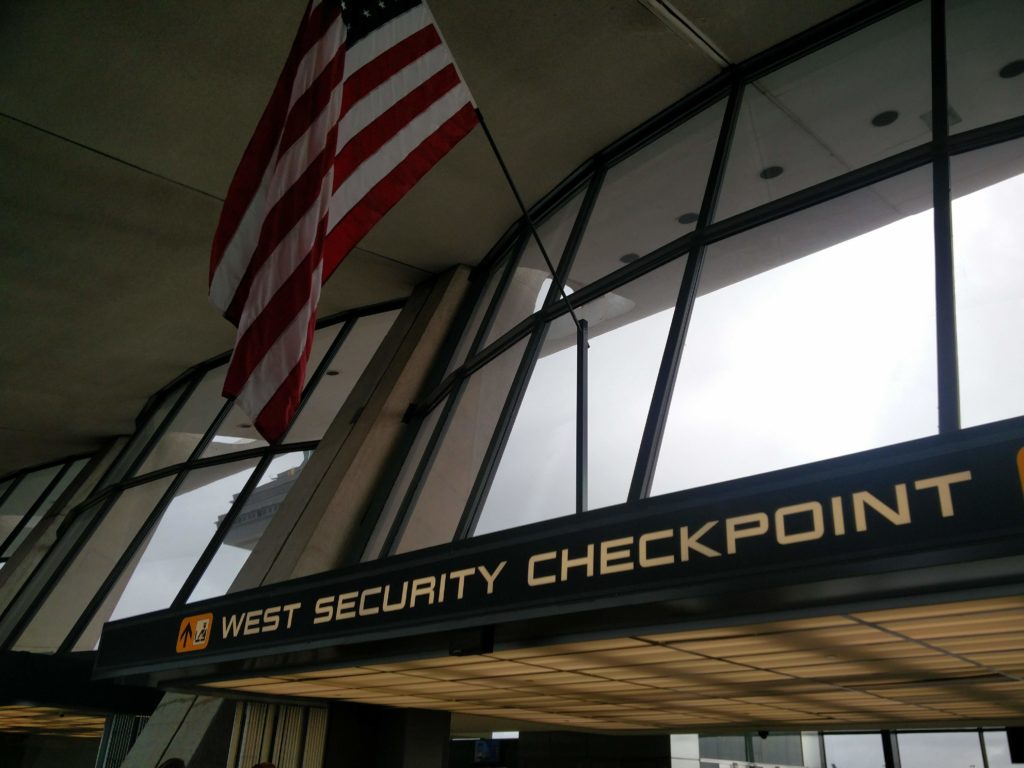
After a few minutes of waiting, we were let through, and the rest of our group asked what happened as we joined them again. The checks through passport control went well, apart from the student who was always stopped at border control. He again pointed to the members of staff that he was travelling with to prove he wasn’t a minor travelling alone (and during term time), so us members of staff are most definitely logged in many databases as escorting children between countries.
The security checks were next, and after struggling to get my laptop out of my carry-on bag (as it was full of everything that I needed on the plane) I was told by the officer to keep my laptop in the bag! Honestly, why are there different controls in place at each airport‽ Everyone was let through security, although one student was not able to find his belt in the tray that he put his stuff into, as he’d been asked to remove it before going through the metal detectors. We looked all around to make sure that he didn’t put it somewhere silly, but it wasn’t anywhere to be found. We asked one of the guards working there if they could find it and they had a look for us. After a few minutes of searching on our behalf, the guard came back from the other side of the metal detector and said that the belt had dropped on the floor through the conveyor belt rollers when it was going into the x-ray machine, so we all thanked this guard for his assistance.
We then made our way to a subway train station, where a train was just arriving that would take us to the terminal building. I wasn’t expecting this, as before we went on the scissor lift busses, but afterwards I realised that was due to us disembarking from the plane and not going to the departures lounge. The train journey took just under two minutes, and after disembarking we went up some long escalators and ended up in the terminal building. We took a seat at one of the gates that was empty, and waited for our flight.
It would be quite a while for us to wait for our flight to be called, so a number of students went off for a walk and explore around the terminal, and I’ve been listening in accidentally overhearing a passenger (on the phone to his flights’ customer services) who is getting irate that he can’t upgrade his seat for the the second leg of his flight. He had only taken this flight due the hurricane (yay, I did get to hear about it again!) causing his other flight to be cancelled, and this was the best route he could find. Supposedly there was an upgrade policy that meant he couldn’t do an upgrade at such short notice, and he certainly made it clear that he won’t be flying with them again. At the end of the call he did mention that it was the worst service that he’s ever had, although he then apologised and said that it wasn’t (if you’re going to make a big deal about something, at least stand by it!).
This was a long terminal. Very long. I went for a walk from one end to the other, and it took many minutes. I saw an Airbus A380 at one of the gates, and this was a humongous plane. There were also display screens in the terminal building and, surprisingly (or perhaps not) there were adverts for Northrop Grumman! Anyway, after walking down to the end of the terminal, I made my way back from the far end to where we’d all been waiting. However, by the time I got back there everyone had gone! I assumed that they’d moved themselves nearer to the gate we’d actually be boarding from, but when I got there, our group was already in the queue. Once I met up with them all again, and they’d asked where I’d gone, it turned out that our flight had been called (which I wasn’t aware of) so they started queuing. Had I known about this, I’d have gone back earlier!
Boarding was uneventful, expect that we had a block of 8 seats in two rows of the four seats in the middle of the plane, but we sat in a different order to what was on our boarding passes. Unfortunately, since we had to show our boarding pass to the stewardess as we got on, they sent me down one side of the aircraft, but in the end I needed to be on the other side to actually get a seat. Luckily, the row behind us was empty, so I was able to cut across to get to the opposite aisle, although trying to go against the flow of people getting onto the plane was fairly difficult. In the end, we were all sorted and took our seats. As we had a few minutes to wait before takeoff, we all started to play games on the screens again. There were some multiplayer games, and a few of the students and myself played a general knowledge game. I joined in partway through the first game, so didn’t get a high score, but the second game I won it. Well, I am about 9-11 years older than the students, but I still count it as a fair victory. Then it was time for takeoff.
We pulled away from the gate and started to taxi to the runway. The pilot announced over the intercom that there was a bit of a queue, but it wouldn’t take too long. Around 10 minutes later we were on the runway, accelerating, taking off and leaving the USA behind.
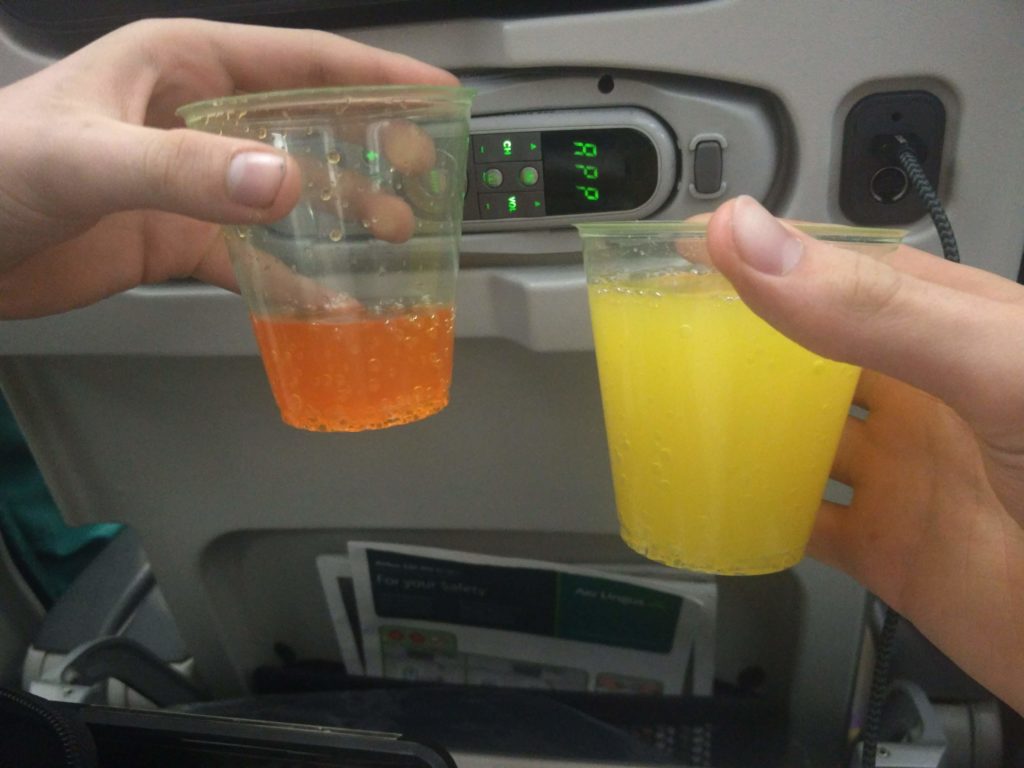
On the flight I played a game of poker, learning quickly on how to play it, and was the last of two players remaining (against a computer). I was winning, but after being $6000 up, I lost it to the final computer player. That was annoying. However, it was such a long game that I played, the evening meal was served while I was still playing. This was useful, as I found out accidentally that the plastic cutlery we were given was a great way to use the screen, due to it being pressure sensitive rather than touch sensitive.
We all finished our meals, and the student who was vegetarian also managed to get a meal without having ordered one, but this took a while to arrive (due to the cabin staff having to serve everyone else on the plane who had ordered a vegetarian meal before they could see how many were spare), the other students kindly handed over their salads for him to eat while he waited (which I think was down to them not really wanting to eat them, rather than out of generosity!). Once the meal had finished there was a lot of turbulence as we crossed over the jet stream, causing the plane to jump around quite a bit. Owing to this, the pilot told everyone to put on their seat belts and that the toilets were out of use. Sods law, but the three students on my row all wanted to now go to the toilet after the meal. It was a few minutes later that the seat belt signs were turned off, but it seemed like most people had to go to the toilet too, as there was now a long queue!
The rest of the flight went smoothly, as we either watched films (I watched Avengers: Infinity War (mainly due to it being a long film to pass the time)) or slept. Quite a lot of other people also slept, so the plane was quite quiet, apart form the engine noise. During this time we passed over the midnight timezone, but we were still on Washington time, so by the time we landed in Dublin we suddenly jumped to 5 in the morning. We had about an hour at Dublin Airport, which was just enough time to go to the departures lounge and pop to the toilet or buy items from duty free. Before we got to the departures lounge (which was the same as when we were going to the United States), we went through transfer flight barriers, but this time everyone had their correct boarding passes so we’re able to get through. We also had to go through passport control, so you can probably guess what happened there!
We then made our way down to the gates which took us past the security area where people who were getting domestic flights came through, and we ended up in another duty free area. Now, whether it was due to most of the group being tired (as we’d been up for a large number of hours) but they walked past the sign which told us to turn off to the gate. Luckily they didn’t get too far before realising and managed to turn back. We then waited in the seating area at the gate for the next plane to be ready.
A few minutes later we were called forward and allowed to board the plane, which was considerably smaller than the previous one. There was a slight delay due to traffic but we did eventually pull away from the terminal. We took off and were told the flight time would be about 35 minutes, massively quicker than the quick flight we thought we had going over to Ireland. On the previous flight from the United States, most of the students boasted that they didn’t sleep, but on this flight most of them were slipping off with their heads dropping and then raising back up again as they tried to stay awake. It was also during this time that sunrise happened, and it was really bright in the cabin. We landed without problems and disembarked the plane.
There was a shuttle bus to take us from the plane to the terminal building, but compared to the distances we’d travelled at the other airports, this was a 30 second journey and you could still clearly see where we started off from. We got off the bus, and made our way to baggage reclaim. Luckily everyone’s cases had been transferred, so we then went through border security, past the guards they are never there, and out to meet the students’ parents at the arrivals exit.
We all were saying about how much we had enjoyed the trip and found it insightful, fun and useful. We said that we’d see the students on Monday morning, wished the student who was off to university the best of luck and started to go our separate ways home. And that was it. The end of a fantastic trip. It was a shame that it was over, but I have a feeling it’s certainly inspired the students, as they’re already planning on sending phishing emails out to train our school staff and thinking of how best to do a capture the flag competition in school.
That’s it, me, Jonathan, signing off. Thanks for reading!
Actually, that was how I was originally going to finish this blog post, but since I’ve had a running theme of putting a screenshot from my phone at the bottom of these CyberCenturion Winners Trip posts, I though it only fair to do the same here (you did notice that I’d been doing that, right?). So, here’s how I’ll actually finish the post off.
As with the students, my parents had turned up to take me home (as I wasn’t planning on spending another £30 on a taxi home, and they wanted to know what we had all got up to). As I hadn’t had a breakfast yet (there were snacks provided on the plane from the United States), we travelled over to The NEC and stopped at the Wetherspoons for food. Once we’d caught up with all of the amazing things that we’d been up to, we caught the train home and I started to write up some draft parts of this post. After I’d done that, I started to watch TV, but then started to feel sleepy. It was around half 3 in the afternoon now, so I decided to have a lie down. Five hours later I woke up. Luckily, just before I fell asleep, I paused the timer on my phone that I had started when I got up in the morning at the hotel in the United States. I’d been awake for over 28 hours!
